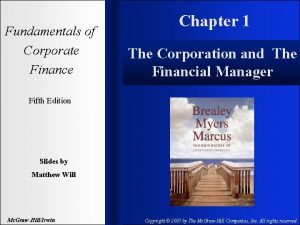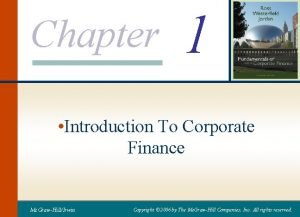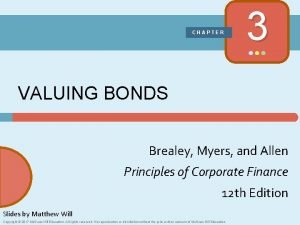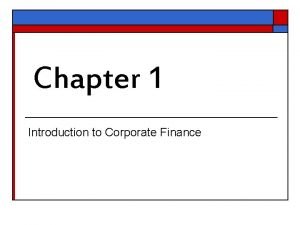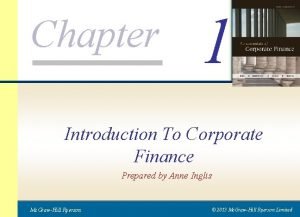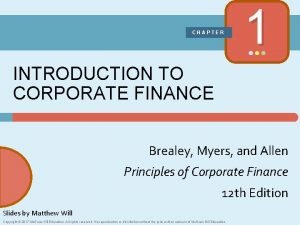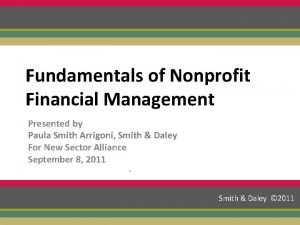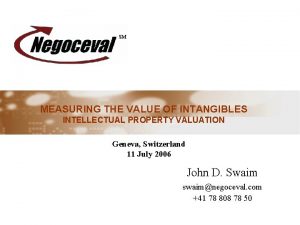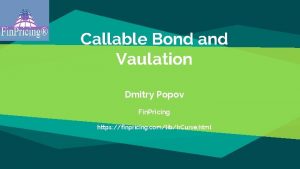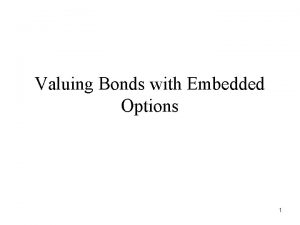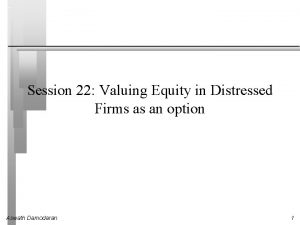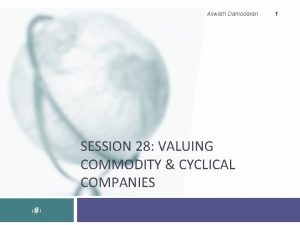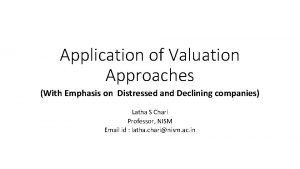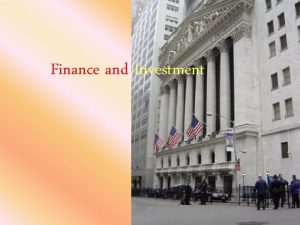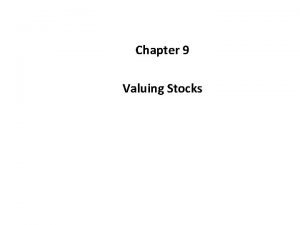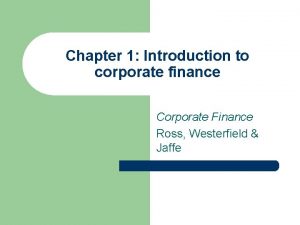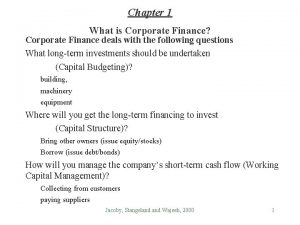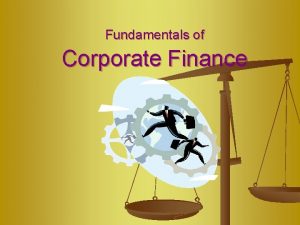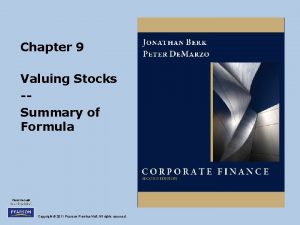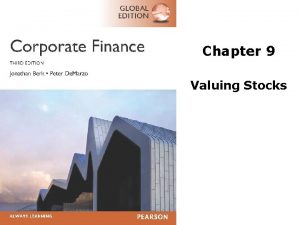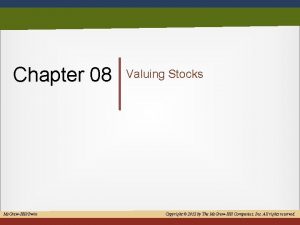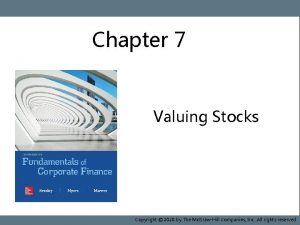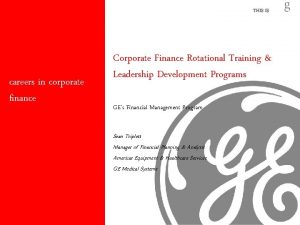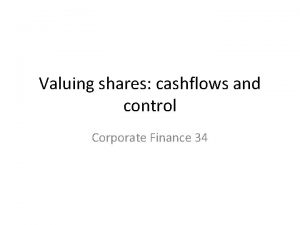Fundamentals of Corporate Finance Chapter 6 Valuing Stocks
































- Slides: 32

Fundamentals of Corporate Finance Chapter 6 Valuing Stocks Fifth Edition Slides by Matthew Will Mc. Graw-Hill/Irwin Copyright © 2007 by The Mc. Graw-Hill Companies, Inc. All rights reserved

6 - 2 Topics Covered ÜStocks and the Stock Market ÜBook Values, Liquidation Values and Market Values ÜValuing Common Stocks ÜSimplifying the Dividend Discount Model ÜGrowth Stocks and Income Stocks ÜThere are no free lunches on Wall Street ÜMarket Anomilies and Behavioral Finance Mc. Graw-Hill/Irwin Copyright © 2007 by The Mc. Graw-Hill Companies, Inc. All rights reserved

6 - 3 Stocks & Stock Market Primary Market - Place where the sale of new stock first occurs. Initial Public Offering (IPO) - First offering of stock to the general public. Seasoned Issue - Sale of new shares by a firm that has already been through an IPO Mc. Graw-Hill/Irwin Copyright © 2007 by The Mc. Graw-Hill Companies, Inc. All rights reserved

6 - 4 Stocks & Stock Market Common Stock - Ownership shares in a publicly held corporation. Secondary Market - market in which already issued securities are traded by investors. Dividend - Periodic cash distribution from the firm to the shareholders. P/E Ratio - Price per share divided by earnings per share. Mc. Graw-Hill/Irwin Copyright © 2007 by The Mc. Graw-Hill Companies, Inc. All rights reserved

6 - 5 Stocks & Stock Market Book Value - Net worth of the firm according to the balance sheet. Liquidation Value - Net proceeds that would be realized by selling the firm’s assets and paying off its creditors. Market Value Balance Sheet - Financial statement that uses market value of assets and liabilities. Mc. Graw-Hill/Irwin Copyright © 2007 by The Mc. Graw-Hill Companies, Inc. All rights reserved

6 - 6 Valuing Common Stocks Expected Return - The percentage yield that an investor forecasts from a specific investment over a set period of time. Sometimes called the holding period return (HPR). Mc. Graw-Hill/Irwin Copyright © 2007 by The Mc. Graw-Hill Companies, Inc. All rights reserved

6 - 7 Valuing Common Stocks The formula can be broken into two parts. Dividend Yield + Capital Appreciation Mc. Graw-Hill/Irwin Copyright © 2007 by The Mc. Graw-Hill Companies, Inc. All rights reserved

6 - 8 Valuing Common Stocks Dividend Discount Model - Computation of today’s stock price which states that share value equals the present value of all expected future dividends. H - Time horizon for your investment. Mc. Graw-Hill/Irwin Copyright © 2007 by The Mc. Graw-Hill Companies, Inc. All rights reserved

6 - 9 Valuing Common Stocks Example Current forecasts are for XYZ Company to pay dividends of $3, $3. 24, and $3. 50 over the next three years, respectively. At the end of three years you anticipate selling your stock at a market price of $94. 48. What is the price of the stock given a 12% expected return? Mc. Graw-Hill/Irwin Copyright © 2007 by The Mc. Graw-Hill Companies, Inc. All rights reserved

6 - 10 Valuing Common Stocks Example Current forecasts are for XYZ Company to pay dividends of $3, $3. 24, and $3. 50 over the next three years, respectively. At the end of three years you anticipate selling your stock at a market price of $94. 48. What is the price of the stock given a 12% expected return? Mc. Graw-Hill/Irwin Copyright © 2007 by The Mc. Graw-Hill Companies, Inc. All rights reserved

6 - 11 Blue Skies Value Mc. Graw-Hill/Irwin Copyright © 2007 by The Mc. Graw-Hill Companies, Inc. All rights reserved

6 - 12 Valuing Common Stocks If we forecast no growth, and plan to hold out stock indefinitely, we will then value the stock as a PERPETUITY. Assumes all earnings are paid to shareholders. Mc. Graw-Hill/Irwin Copyright © 2007 by The Mc. Graw-Hill Companies, Inc. All rights reserved

6 - 13 Valuing Common Stocks Constant Growth DDM - A version of the dividend growth model in which dividends grow at a constant rate (Gordon Growth Model). Given any combination of variables in the equation, you can solve for the unknown variable. Mc. Graw-Hill/Irwin Copyright © 2007 by The Mc. Graw-Hill Companies, Inc. All rights reserved

6 - 14 Valuing Common Stocks Example What is the value of a stock that expects to pay a $3. 00 dividend next year, and then increase the dividend at a rate of 8% per year, indefinitely? Assume a 12% expected return. Mc. Graw-Hill/Irwin Copyright © 2007 by The Mc. Graw-Hill Companies, Inc. All rights reserved

6 - 15 Valuing Common Stocks Example- continued If the same stock is selling for $100 in the stock market, what might the market be assuming about the growth in dividends? Answer The market is assuming the dividend will grow at 9% per year, indefinitely. Mc. Graw-Hill/Irwin Copyright © 2007 by The Mc. Graw-Hill Companies, Inc. All rights reserved

6 - 16 Valuing Common Stocks Ü If a firm elects to pay a lower dividend, and reinvest the funds, the stock price may increase because future dividends may be higher. Payout Ratio - Fraction of earnings paid out as dividends Plowback Ratio - Fraction of earnings retained by the firm. Mc. Graw-Hill/Irwin Copyright © 2007 by The Mc. Graw-Hill Companies, Inc. All rights reserved

6 - 17 Valuing Common Stocks Growth can be derived from applying the return on equity to the percentage of earnings plowed back into operations. g = return on equity X plowback ratio Mc. Graw-Hill/Irwin Copyright © 2007 by The Mc. Graw-Hill Companies, Inc. All rights reserved

6 - 18 Valuing Common Stocks Example Our company forecasts to pay a $5. 00 dividend next year, which represents 100% of its earnings. This will provide investors with a 12% expected return. Instead, we decide to plow back 40% of the earnings at the firm’s current return on equity of 20%. What is the value of the stock before and after the plowback decision? Mc. Graw-Hill/Irwin Copyright © 2007 by The Mc. Graw-Hill Companies, Inc. All rights reserved

6 - 19 Valuing Common Stocks Example Our company forecasts to pay a $5. 00 dividend next year, which represents 100% of its earnings. This will provide investors with a 12% expected return. Instead, we decide to blow back 40% of the earnings at the firm’s current return on equity of 20%. What is the value of the stock before and after the plowback decision? No Growth Mc. Graw-Hill/Irwin With Growth Copyright © 2007 by The Mc. Graw-Hill Companies, Inc. All rights reserved

6 - 20 Valuing Common Stocks Example - continued If the company did not plowback some earnings, the stock price would remain at $41. 67. With the plowback, the price rose to $75. 00. The difference between these two numbers (75. 0041. 67=33. 33) is called the Present Value of Growth Opportunities (PVGO). Mc. Graw-Hill/Irwin Copyright © 2007 by The Mc. Graw-Hill Companies, Inc. All rights reserved

6 - 21 Valuing Common Stocks Present Value of Growth Opportunities (PVGO) - Net present value of a firm’s future investments. Sustainable Growth Rate - Steady rate at which a firm can grow: plowback ratio X return on equity. Mc. Graw-Hill/Irwin Copyright © 2007 by The Mc. Graw-Hill Companies, Inc. All rights reserved

6 - 22 No Free Lunches ÜTechnical Analysts èForecast stock prices based on the watching the fluctuations in historical prices (thus “wiggle watchers”) watchers Mc. Graw-Hill/Irwin Copyright © 2007 by The Mc. Graw-Hill Companies, Inc. All rights reserved

6 - 23 No Free Lunches Scatter Plot of NYSE Composite Index over two successive weeks. Where’s the pattern? Mc. Graw-Hill/Irwin Copyright © 2007 by The Mc. Graw-Hill Companies, Inc. All rights reserved

6 - 24 Random Walk Theory ÜThe movement of stock prices from day to day DO NOT reflect any pattern. ÜStatistically speaking, the movement of stock prices is random (skewed positive over the long term). Mc. Graw-Hill/Irwin Copyright © 2007 by The Mc. Graw-Hill Companies, Inc. All rights reserved

6 - 25 Random Walk Theory Coin Toss Game Heads $106. 09 $103. 00 Tails $100. 43 $100. 00 Heads Tails $97. 50 Tails Mc. Graw-Hill/Irwin $100. 43 $95. 06 Copyright © 2007 by The Mc. Graw-Hill Companies, Inc. All rights reserved

6 - 26 Random Walk Theory Mc. Graw-Hill/Irwin Copyright © 2007 by The Mc. Graw-Hill Companies, Inc. All rights reserved

6 - 27 Random Walk Theory Mc. Graw-Hill/Irwin Copyright © 2007 by The Mc. Graw-Hill Companies, Inc. All rights reserved

6 - 28 Random Walk Theory Market Index 1, 300 1, 200 1, 100 Cycles disappear once identified Mc. Graw-Hill/Irwin Last Month This Month Next Month Copyright © 2007 by The Mc. Graw-Hill Companies, Inc. All rights reserved

6 - 29 Another Tool ÜFundamental Analysts èResearch the value of stocks using NPV and other measurements of cash flow Mc. Graw-Hill/Irwin Copyright © 2007 by The Mc. Graw-Hill Companies, Inc. All rights reserved

6 - 30 Efficient Market Theory ÜWeak Form Efficiency èMarket prices reflect all historical information ÜSemi-Strong Form Efficiency èMarket prices reflect all publicly available information ÜStrong Form Efficiency èMarket prices reflect all information, both public and private Mc. Graw-Hill/Irwin Copyright © 2007 by The Mc. Graw-Hill Companies, Inc. All rights reserved

6 - 31 Efficient Market Theory Announcement Date Mc. Graw-Hill/Irwin Copyright © 2007 by The Mc. Graw-Hill Companies, Inc. All rights reserved

6 - 32 Behavioral Finance ÜAttitudes towards risk ÜBeliefs about probabilities Mc. Graw-Hill/Irwin Copyright © 2007 by The Mc. Graw-Hill Companies, Inc. All rights reserved
 Fundamentals of corporate finance chapter 6 solutions
Fundamentals of corporate finance chapter 6 solutions Examples of agency problems
Examples of agency problems Fundamentals of corporate finance, chapter 1
Fundamentals of corporate finance, chapter 1 Fundamentals of corporate finance, third canadian edition
Fundamentals of corporate finance, third canadian edition Fundamentals of corporate finance canadian edition
Fundamentals of corporate finance canadian edition Fundamentals of corporate finance fifth edition
Fundamentals of corporate finance fifth edition Fundamentals of corporate finance 6th edition
Fundamentals of corporate finance 6th edition Goal of corporate finance
Goal of corporate finance Common stock characteristics
Common stock characteristics Introduction to corporate finance what companies do
Introduction to corporate finance what companies do Principles of corporate finance chapter 3 solutions
Principles of corporate finance chapter 3 solutions Chapter 1 introduction to corporate finance
Chapter 1 introduction to corporate finance Chapter 1 introduction to corporate finance
Chapter 1 introduction to corporate finance Chapter 1 introduction to corporate finance
Chapter 1 introduction to corporate finance Finance fundamentals for nonprofits
Finance fundamentals for nonprofits Real estate finance fundamentals
Real estate finance fundamentals Valuing a private company
Valuing a private company Affective learning outcomes
Affective learning outcomes Psychomotor objectives examples
Psychomotor objectives examples Covert behavior examples
Covert behavior examples Triumvirate rome
Triumvirate rome Oral language quotes
Oral language quotes Valuing innovation
Valuing innovation Valuing intangible assets
Valuing intangible assets Aspects of honesty
Aspects of honesty Callable bond definition
Callable bond definition Valuing bonds with embedded options
Valuing bonds with embedded options Valuing distressed companies
Valuing distressed companies Valuing culture
Valuing culture Valuing land for social housing
Valuing land for social housing Valuing cyclical companies
Valuing cyclical companies Valuing distressed and declining companies
Valuing distressed and declining companies Chapter 6 stocks sauces and soups
Chapter 6 stocks sauces and soups


